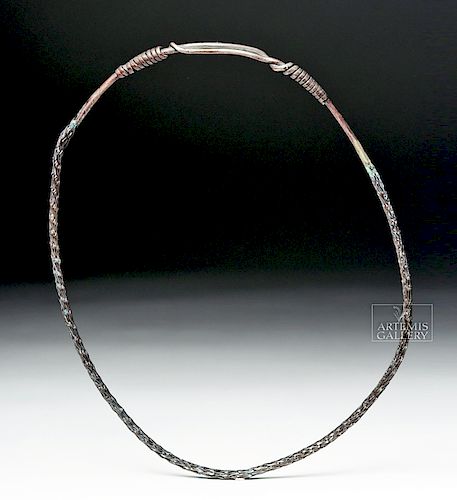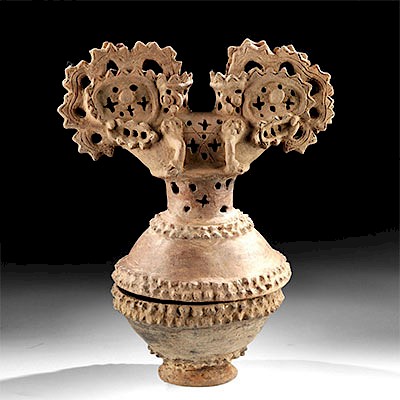Heavy Viking Silver Trichinopoly Torc
Lot 37d
About Seller
Artemis Gallery
686 S Taylor Ave, Ste 106
Louisville, CO 80027
United States
Selling antiquities, ancient and ethnographic art online since 1993, Artemis Gallery specializes in Classical Antiquities (Egyptian, Greek, Roman, Near Eastern), Asian, Pre-Columbian, African / Tribal / Oceanographic art. Our extensive inventory includes pottery, stone, metal, wood, glass and textil...Read more
Categories
Estimate:
$2,000 - $3,000
Absentee vs Live bid
Two ways to bid:
- Leave a max absentee bid and the platform will bid on your behalf up to your maximum bid during the live auction.
- Bid live during the auction and your bids will be submitted real-time to the auctioneer.
Bid Increments
| Price | Bid Increment |
|---|---|
| $0 | $25 |
| $300 | $50 |
| $1,000 | $100 |
| $2,000 | $250 |
| $5,000 | $500 |
| $10,000 | $1,000 |
| $20,000 | $2,500 |
| $50,000 | $5,000 |
| $100,000 | $10,000 |
| $200,000 | $20,000 |
About Auction
By Artemis Gallery
Aug 22, 2019
Set Reminder
2019-08-22 10:00:00
2019-08-22 10:00:00
America/New_York
Bidsquare
Bidsquare : Fine Ancient | Asian | Ethnographic Art
https://www.bidsquare.com/auctions/artemis-gallery/fine-ancient-asian-ethnographic-art-4348
Featuring classical antiquities, ancient and ethnographic art from cultures encompassing the globe, plus fine art. Egyptian, Greek, Roman, Etruscan, Near Eastern, Asian, Pre-Columbian, Native American, African / Tribal, Oceanic, Spanish Colonial, Russian, Fine Art, so much more! Artemis Gallery info@artemisgallery.com
Featuring classical antiquities, ancient and ethnographic art from cultures encompassing the globe, plus fine art. Egyptian, Greek, Roman, Etruscan, Near Eastern, Asian, Pre-Columbian, Native American, African / Tribal, Oceanic, Spanish Colonial, Russian, Fine Art, so much more! Artemis Gallery info@artemisgallery.com
- Lot Description
Northern Europe, Viking / Norse culture, ca. 10th century CE. A heavy, large silver torc (torq, torque), exquisitely constructed. The majority of the torq is a densely woven silver trichinopoly chain - also known as "Viking knit." This forms a flexible ring that terminates in hammered silver sheet wrapped around its ends. The sheet tapers to thick silver wires that wrap around each other to form a permanent clasp. This is really a gorgeous item that would have signified wealth and high social status for its wearer, who may have been a man or a woman in Viking society. The torc likely ended its functional life deposited in a river or lake, probably as an offering to the gods. Size: 11.4" W (29 cm); 90.1 grams
Old Icelandic Viking literature brings us a story about the power of torcs like this one. The goddess Freyja owned a torc called Brisingamen, of which the first half of the compound word, brisingr, means "fire"or "amber", and the second half, "men", means "neck ring/torc of precious metal". This gleaming torc is so famous that it is mentioned in "Beowulf", the "Poetic Edda", the "Prose Edda", and the "Flateyjarbok Saga" (and later inspired a story in J. R. R. Tolkien's "The Silmarillion"). In various stories, it is stolen, often by the trickster god Loki, and Freyja's wrath is terrible until the necklace is returned to her. In the "Poetic Edda", Thor borrows Brisingamen to disguise himself as Freyja and attend a wedding in the homeland of the giants, Jotunheimr. The importance of the torc as a signifier of social standing - especially related to one of the most powerful women of the Norse pantheon - emphasizes what a fine item this example is.
Provenance: private New York, New York, USA collection
All items legal to buy/sell under U.S. Statute covering cultural patrimony Code 2600, CHAPTER 14, and are guaranteed to be as described or your money back.
A Certificate of Authenticity will accompany all winning bids.
We ship worldwide and handle all shipping in-house for your convenience.
#131104Dark patina on much of the surface, with a small area of copper patina near one of the terminals, probably related to depositional environment. Amethyst in photo for display purposes.Condition
- Shipping Info
-
All shipping is handled in-house for your convenience. Your invoice from Artemis Gallery will include shipping calculation instructions. If in doubt, please inquire BEFORE bidding for estimated shipping costs for individual items.
-
- Buyer's Premium



 EUR
EUR CAD
CAD AUD
AUD GBP
GBP MXN
MXN HKD
HKD CNY
CNY MYR
MYR SEK
SEK SGD
SGD CHF
CHF THB
THB














